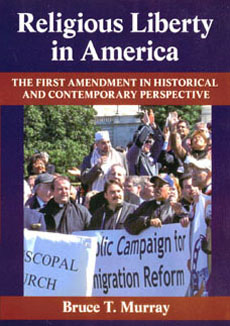Supreme Court in the spotlight
UMass Press book provides analyses of new justices on the High Court
Recent high-profile television interviews by Supreme Court Justices Antonin Scalia and Clarence Thomas have brought a new public persona to the traditionally insular High Court. Although such appearances provide tantalizing glimpses into the personalities of individuals on the Court, they provide little in the way of understanding the justices’ legal processes and reasoning.

The University of Massachusetts Press book, Religious Liberty in America: The First Amendment in Historical and Contemporary Perspective by Bruce T. Murray, explores the Supreme Court’s evolution in its interpretation of the First Amendment for the past 200-plus years. The book places particular emphasis on the current configuration of the Court and provides analyses of its newest members, John Roberts and Sam Alito.
Murray’s book further surveys the development of religious pluralism in America for the past 400 years – from early colonial times to present controversies, such as the mixing of religion and politics, battles over religious symbols in the public square, the “culture wars,” immigration and faith-based initiatives.
Religious Liberty in America was selected by Choice – a publication of the Association of College and Research Libraries – as an “Outstanding Academic Book,” and it has received numerous other favorable reviews:
“Murray explores numerous cases in public law, especially as they illustrate the changing landscape of interpretations of the First Amendment. He looks at faith-based initiatives (Bush's legislation), issues involving religious liberty in public schools, and other topics that illustrate that the ‘wall of separation’ has been rather porous. Murray is very effective in showing how terms such as ‘liberal,’ ‘conservative,’ judicial ‘activism,’ and judicial ‘restraint’ are actually moving and evolving targets.”
— G.H. Shriver, Professor Emeritus, Georgia Southern University (from the October, 2008 issue of Choice, a publication of the Association of College and Research Libraries, a division of the American Library Association.)
“This concise and readable book discusses topics relating to the religion clauses of the First Amendment and, more generally, to the interaction of religion and politics in the United States. ... It is a highly accessible introduction to the topics it addresses, complete with references for documentation or further reading. ... The book is well written, engaging, and balanced in its presentations of competing views.”
— Daniel O. Conkle, Professor of Law and Adjunct Professor of Religious Studies, Indiana University (from the July, 2009 issue of the Catholic Historical Review).
“Murray’s final chapter is by far the most intriguing and well written. In this seventh chapter entitled ‘The Supreme Court and the First Amendment’, Murray allows the Justices themselves to tell the history of First Amendment jurisprudence by relying upon their own official opinions – majority, concurring, and dissenting ... Touching on the most contentious cases including those concerning school prayer, holiday displays, and illicit drug use, this chapter also delves into the opposing ‘tests’ employed by the Supreme Court for establishing the Constitutionality of the interaction of religion and government.”
— Brandon M. Crowe, Ph.D., School of Historical, Philosophical and Religious Studies, Arizona State University
(from Reviews in Religion & Theology, History and Sociology of Religion, Wiley-Blackwell Publishing, Vol. 17, Issue 2, 2010)
Purchase Religious Liberty in America from the University of Massachusetts Press.
Find out more about the author here.

